
Flowering now, almost a month later than usual. I fell in love with this shrub at Winterthur where Dupont planted a long walk of corylopsis or fragrant winterhazel underplanted with helleborus. More subtle than the yellow of forsythia, the fragrant flowers glow in spring sunshine and are complemented wonderfully by the smokey purple hellebores.
The Facts
Family: Hamamelidaceae
Genus: Corylopsis Species: glabrescens Common Name: Fragrant Winterhazel
Area of Origin: Japan
Characteristics: Another large multi-stemmed deciduous spring flowering woody shrub (usually 8' - 15' tall with a similar spread) which is somewhat flat-topped, rounded. Simple, ovate, alternate leaves are 2" - 4" long and have bristle-like teeth a wonderful chartreuse color in spring turning dark green. Fall color varies from yellow-green to clear gold. The flowers are perfect, pale yellow and fragrant, borne in 1" - 1 1/2" long pendulous racemes and flower from March - April before the leaves.
Hardiness: USDA Zones 5 to 8.
Cultivation needs: Easy to grow, prefers full sun to light shade, ours is at the edge of the woods and in summer months is in fairly deep shade. Likes moist, acid, preferably well-drained soil that has been amended with peat moss or leaf mold. It's a great plant for early spring color and fragrance and can be successfully integrated into shrub borders. It's best planted in front of an evergreen background so the flowers really pop.
Typical Pests, Diseases, associated problems: Like most members of the family it is free from significant problems.
Propagation Method: Seeds are difficult and require a 5 month/3 month warm/cold period so well beyond my patience. Softwood cuttings root easily and can be gathered throughout June, July and August with a 90% success rate when dipped in rooting hormone. However, Dirr notes that the cuttings are resistant to moving and should go through a dormancy cycle before transplanting.
The Facts
Family: Hamamelidaceae
Genus: Corylopsis Species: glabrescens Common Name: Fragrant Winterhazel
Area of Origin: Japan
Characteristics: Another large multi-stemmed deciduous spring flowering woody shrub (usually 8' - 15' tall with a similar spread) which is somewhat flat-topped, rounded. Simple, ovate, alternate leaves are 2" - 4" long and have bristle-like teeth a wonderful chartreuse color in spring turning dark green. Fall color varies from yellow-green to clear gold. The flowers are perfect, pale yellow and fragrant, borne in 1" - 1 1/2" long pendulous racemes and flower from March - April before the leaves.
Hardiness: USDA Zones 5 to 8.
Cultivation needs: Easy to grow, prefers full sun to light shade, ours is at the edge of the woods and in summer months is in fairly deep shade. Likes moist, acid, preferably well-drained soil that has been amended with peat moss or leaf mold. It's a great plant for early spring color and fragrance and can be successfully integrated into shrub borders. It's best planted in front of an evergreen background so the flowers really pop.
Typical Pests, Diseases, associated problems: Like most members of the family it is free from significant problems.
Propagation Method: Seeds are difficult and require a 5 month/3 month warm/cold period so well beyond my patience. Softwood cuttings root easily and can be gathered throughout June, July and August with a 90% success rate when dipped in rooting hormone. However, Dirr notes that the cuttings are resistant to moving and should go through a dormancy cycle before transplanting.

 RSS Feed
RSS Feed
